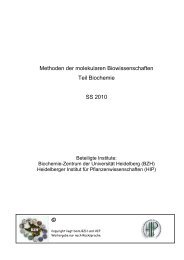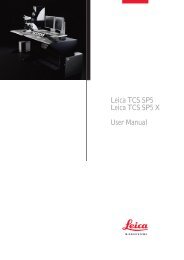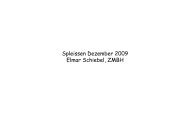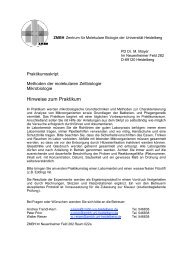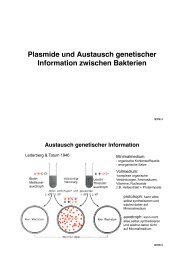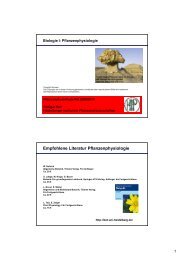ZMBH J.Bericht 2000 - Zentrum für Molekulare Biologie der ...
ZMBH J.Bericht 2000 - Zentrum für Molekulare Biologie der ...
ZMBH J.Bericht 2000 - Zentrum für Molekulare Biologie der ...
Create successful ePaper yourself
Turn your PDF publications into a flip-book with our unique Google optimized e-Paper software.
Library<br />
The library of the <strong>ZMBH</strong> offers a number of services<br />
to support the research groups of the <strong>ZMBH</strong>. Subscriptions<br />
to 43 scientific journals and 23 monographic<br />
series are being entertained and the access to<br />
online journals has been increased to 193 journals via<br />
the central library of the university. While the online<br />
journals can be accessed from every lab in the institute,<br />
two computers within the library allow in addition<br />
to use our collection of CD-ROMs which include<br />
e. g. „Current Protocols in Molecular Biology“ and<br />
„Current Protocols in Protein Science“. Finally, access<br />
to articles from way out journals or backissues is provided<br />
via the University‘s copy service.<br />
Besides all the hard- and software support, the library<br />
is a place for quiet and undisturbed study away from<br />
the sometimes hectic activity at the bench.<br />
142<br />
Hermann Bujard<br />
Documentation Service<br />
The <strong>ZMBH</strong> documentation service supply all type of<br />
visual communication supports. This service includes<br />
computer graphics, photography and graphic arts activities.<br />
The service provides drawings and figures destined<br />
for publications, poster sessions or conferences. The<br />
visual supports are produced as black and white or<br />
colour prints, as overhead transparencies or as slides.<br />
The computerized equipment of the service is based<br />
on two Apple Computers connected to a desktop colour<br />
scanner, a slide scanner, a 35 mm film exposure<br />
unit and InkJet photo quality colour printers A4 to<br />
A2 size. Software used are Canvas and Illustrator<br />
for drawing, Photoshop for photographic touchingup,<br />
QuarkXPress for DTP work and PowerPoint for<br />
slide production.<br />
Scientific photography is increasingly handled by<br />
computerized processes-which give high quality results<br />
in shorter times. For those who want to learn the<br />
use of these new imaging methods, the documentation<br />
service provides advice and courses.<br />
Finally other products of this service lab include any<br />
kind of photographic shots during <strong>ZMBH</strong> symposia<br />
and the desktop publishing and layout of the annual<br />
report as well as other documents that the <strong>ZMBH</strong><br />
edits.<br />
Yves Cully<br />
Central Administration<br />
The management of all personnel, of finances and of<br />
various administrative and technical facilities of the<br />
<strong>ZMBH</strong> lies within the responsibilities of our institute‘s<br />
central administration.<br />
During 1998/99, about 250 individuals have been<br />
working at the <strong>ZMBH</strong>. They include approx. 70 Ph.D.<br />
students, approx. 40 postdoctoral scientists and scholarship<br />
hol<strong>der</strong>s from 15 nations. In addition we have 3<br />
foreign group-lea<strong>der</strong>s and many guest scientists from<br />
foreign countries. As usual, we had a high turnover<br />
rate of approx. 100 per year.<br />
The <strong>ZMBH</strong>‘s financial structure is quite complex. The<br />
state of Baden-Württemberg has, for the past years,<br />
been the only basic financial supporter of the institute,<br />
which has allowed an effective and efficient management<br />
of the <strong>ZMBH</strong>‘s financial resources. However,<br />
the institute has also been affected by the drastic<br />
financial cuts in the public sector. In real terms, this<br />
means the loss of 5 staff positions until 2002 in the<br />
central infrastructure. Such personnel reductions can<br />
only be made by restructuring the work profile in the<br />
central services for maximum efficiency. To compensate<br />
for the job cuts, the <strong>ZMBH</strong> has been given the<br />
assurance of basic financial support for the coming<br />
years.<br />
From 1998-1999, the development of financial support<br />
outside the public sector corresponded to the number<br />
of occupied research group lea<strong>der</strong> positions.Due to the<br />
high staff fluctuation on this level as well as the complicated<br />
proceedings in the appointment of a professorship,<br />
there has been a noticeable drop in external<br />
funding for this period as compared with the previous<br />
period from 1996-1997. This trend is expected to even<br />
out when all the vacant research group lea<strong>der</strong> positions<br />
are filled.<br />
In 1998, the central administration introduced a data<br />
base system in the areas of finance and personnel.<br />
With this system, all research group lea<strong>der</strong>s, secretaries<br />
as well as staff members holding key functions<br />
are able to obtain in varying detail important financial<br />
and personnel information online. The next step is the<br />
coordination of this system with the SAP-data base<br />
system used by the main administration of the University<br />
of Heidelberg. The setting up and maintenance of<br />
the data base at the <strong>ZMBH</strong> plays a central role in<br />
the <strong>ZMBH</strong> administration by optimising and linking<br />
the administrative tasks as well as the wide range of<br />
support services available to the staff members for<br />
research and teaching.<br />
Jürgen Auer<br />
143



